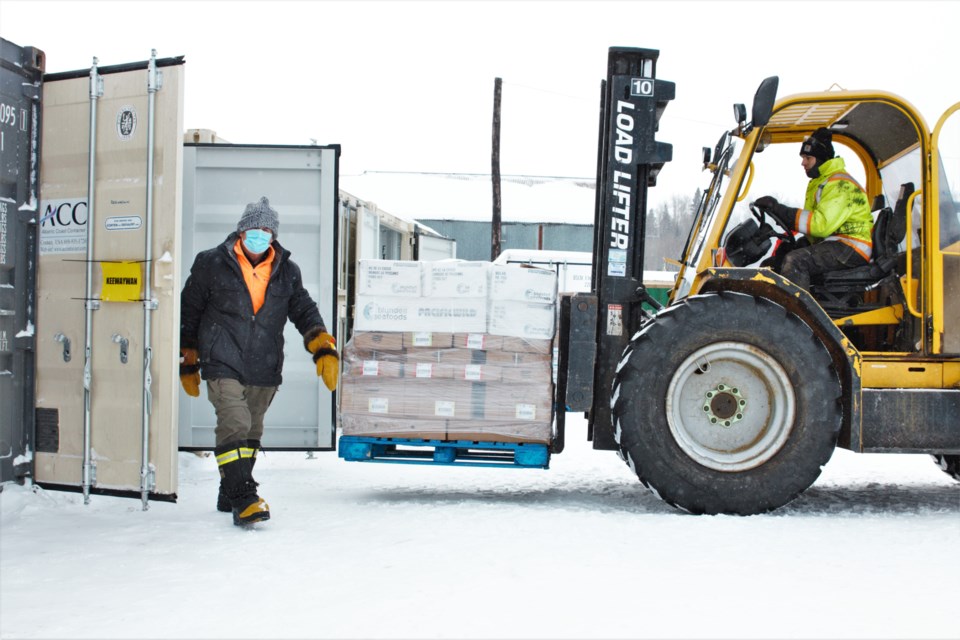THUNDER BAY – A project sending large amounts of food to remote First Nations in northwestern Ontario is a step on the path toward more permanent food security solutions, says one chief.
A partnership between the Regional Food Distribution Association (RFDA) and the Nishnawbe Aski Police Service (NAPS) will see shipping containers, each containing thousands of pounds of donated food, delivered to 13 communities by winter road.
Rod Brown, lead of a NAPS radio project to connect the communities to a central OPP communications and dispatch system, saw an opportunity as he prepared to ship generators and other equipment to the communities.
He reached out to the RFDA when he realized the loads would fill only about half of each shipping container. That left valuable space for the communities that rely on air deliveries most of the year.
The timing was ideal, said RFDA executive director Volker Kromm, as the organization is being offered unprecedented amounts of food from large producers.
“There’s quite a surplus of high-value protein across Canada because of the pandemic,” he said. “If you imagine all the restaurants that are shut down, a lot of this food is becoming available.”
That included premier products like bison, fish, and crab meat, he said.
“To avoid any food in Canada going to landfill, we’ve put our hand up saying we’ll take it – there are people who certainly would appreciate having access to that food.”
It’s the first time the RFDA will send food to the remote communities by winter road, rather than by air, an opportunity Kromm was thankful for.
The organization loaded three pallets, each bearing about 1,000 to 2,000 pounds of food, into each shipping container. The containers themselves will remain in the communities after they arrive over the coming weeks.
“They become really useful,” said Eabametoong First Nation chief Harvey Yesno of the corrugated metal containers.
His community, located about 360 kilometres north of Thunder Bay, will insulate theirs and use it to store future food shipments.
When donated food is received from the RFDA or elsewhere, a team of volunteers sorts and distributes it to the community, Yesno explained.
“Sometimes the stuff comes in on a weekend and we can’t readily get people to help out,” he said.
The situation is similar in many other remote communities the RFDA works to assist, according to Kromm.
“When it gets to the community, there’s no place to put the product,” he said. “We develop a relationship with each community, they assign a champion and they manage the receiving and the distribution... At least this will give us a place where they can store [it] and distribute from there.”
The container will provide a useful stopgap, Yesno said, but it points to the need for more sustainable solutions.
In the longer term, he envisions a permanent structure with a walk-in fridge and freezer, as well as multi-purpose meeting space that could be used for programming like nutrition classes and fly-in court. He's not yet sure if such a project could qualify for government funding.
Despite recent efforts to build more self-sufficiency, he said the community still faces a great deal of food insecurity.
“I think COVID woke a lot of people up,” he said, as the pandemic disrupted supply chains and left local shelves bare of some items.
That only exacerbated existing problems: a bag of milk that costs $5 in Thunder Bay might sell for triple that in Eabametoong, Yesno said. That can put healthy food out of reach.
The community has seen success with other recent strategies to boost food security.
A community garden launched with the help of DeBruin’s Greenhouses has flourished, producing over 80,000 pounds of produce in recent years, Yesno said, and he’s noticed smaller gardens cropping up in people’s yards.
It’s one piece of the food security puzzle, he said, but can only go so far in the face of major structural problems. The First Nation remains under a boil water advisory, and a lack of housing has left a number of members living in tent frames even through the recent cold snap, he reported.
“Our community is still vulnerable,” he said. “We need to find other ways to [achieve] self-sufficiency.”
Kromm was happy to see the containers headed north, but agreed more permanent solutions are needed. In the medium term, he sees opportunities to work with First Nations and government to fund new approaches like refrigerated shipping containers.
That would allow organizations like his to ship perishable food to remote communities all year round, he said.
“That’s always the biggest problem, is having the infrastructure in each community,” he said.
